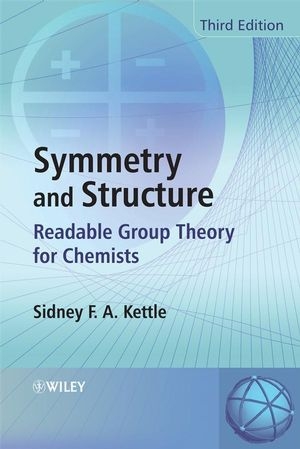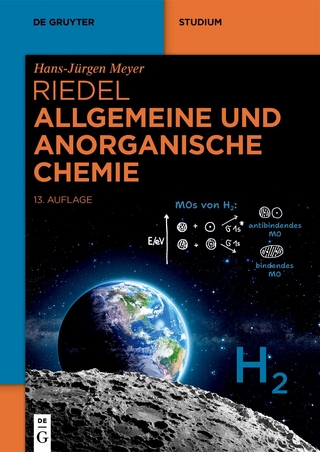
Symmetry and Structure
John Wiley & Sons Inc (Verlag)
978-0-470-06039-1 (ISBN)
Building on the foundation of the Second Edition, Symmetry and Structure: Readable Group Theory for Chemists, Third Edition turns the complex and potentially difficult subject of group theory into an accessible and readable account of this core area of chemistry. By using a diagrammatical approach and demonstrating the physical principles involved in understanding group theory, the text provides a non-mathematical, yet thorough, treatment of this broad topic. This new edition has been fully revised and updated to include a much more three-dimensional and accurate visualization of many of the key topics. The chapter on octahedral molecules is extended to cover the important topic of the ligand field theory of octahedral transition metal complexes. Problems and summaries are included at the end of each chapter, the book provides detailed answers to frequently asked questions, and numerous diagrams and tables are featured for ease of reading and to enhance student understanding.
Symmetry and Structure: Readable Group Theory for Chemists, Third Edition is an essential textbook for all students, researchers and lecturers in chemistry, biochemistry, chemical engineering, physics and material science.
Professor Sidney Kettle. Retired, formerly Professor of Inorganic Chemistry, University of East Anglia, UK.
Preface to Third Edition.
Preface to Second Edition.
Preface to First Edition.
1-Theories in conflict.
1.1 Introduction.
1.2 The ammonia molecule.
1.2.1 The atomic orbital model.
1.2.2 The hybrid orbital model.
1.2.3 The electron repulsion model.
1.2.4 The electron spin repulsion model.
1.2.5 Accurate calculations.
2-The symmetry of the water molecule.
2.1 Symmetry operations and symmetry elements.
2.2 Multipliers associated with symmetry operations.
2.3 Group multiplication tables.
2.4 Character tables.
2.5 Summary.
3- The electronic structure of the water molecule.
3.1 The orthonormal properties of irreducible representations.
3.2 The transformation properties of atomic orbitals in the water molecule.
3.3 A reducible representation.
3.4 Symmetry adapted combinations.
3.5 The bonding interactions in H2O and their angular dependence.
3.6 The molecular orbital energy level diagram for H2O.
3.7 Comparison with experiment.
3.8 The Walsh diagram for triatomic dihydrides.
3.9 Simple models for the bonding in H2O.
3.10 A rapprochement between simple and symmetry models.
3.11 Summary.
4-Vibrational spectra of the water molecule.
4.1 Vibrations of the water molecule: Part 1 (easy).
4.2 Vibrations of the water molecule: Part 2 (less easy!).
4.3 Product functions.
4.4 Direct products and quantum mechanical integrals.
4.5 Spectroscopic selection rules.
4.6 The vibrational spectroscopy of the water molecule.
4.7 Optical activity.
4.8 Summary.
5-The D2h character table and the electronic structures of ethene (ethylene) and diborane.
5.1 The symmetry of the ethene molecule.
5.2 The character and multiplication tables of the D2h group.
5.3 Direct products of groups.
5.4 Nodal patterns of the irreducible representations of the D2h group.
5.5 The symmetries of the carbon atomic orbitals in ethene.
5.6 The symmetries of the hydrogen 1s orbitals in ethene.
5.7 The projection operator method.
5.8 Bonding in the ethene molecule.
5.9 Bonding in the diborane molecule.
5.10 Comparison with other models.
5.11 Summary.
6-The electronic structure of bromine pentafluoride, BrF5.
6.1 Symmetry operations of the C4v group.
6.2 Problems in using the C4v group.
6.3 Orthonormality relationships.
6.4 The derivation of the C4v character table using the orthonormality theorems.
6.5 Nodal patterns of the irreducible representations of C4v.
6.6 The bonding in the BrF5 molecule.
6.7 Summary.
7-The electronic structure of the ammonia molecule.
7.1 The symmetry of the ammonia molecule.
7.2 Nodal patterns of the irreducible representations of C3v.
7.3 The bonding in the ammonia molecule.
7.4 Summary.
8-The electronic structures of some octahedral molecules.
8.1 The symmetry operations of the octahedron.
8.2 Nodal patterns of the irreducible representations of the Oh group.
8.3 The bonding in the SF6, molecule.
8.4 Octahedral transition metal complexes.
8.5 Summary.
9. Point groups and their relationships.
9.1 The determination of the point group of a molecule.
9.2 The relationships between point groups.
9.3 Correlation tables.
9.4 Summary.
10-Tetrahedral, icosahedral and spherical symmetries.
10.1 An overview.
10.2 The tetrahedron.
10.3 The icosahedron.
10.4 Spherical symmetry.
10.5 Linear molecules.
10.6 Summary.
11-Electron systems.
11.1 Square cyclobutadiene and the C4 point group.
11.2 Working with complex characters.
11.3 The p orbitals of cyclobutadiene.
11.4 The energies of the p orbitals of cyclobutadiene in the Hckel approximation.
11.5 Symmetry and chemical reactions.
11.6 Summary.
12 The group theory of electron spin.
12.1 The problem of electron spin.
12.2 More about the symmetry of product functions.
12.3 Configurations and terms.
12.4 The inclusion of electron spin.
12.5 Summary.
13-Space groups.
13.1 The crystal systems.
13.2 The Bravais lattices.
13.3 The crystallographic point groups.
13.4 The symmorphic space groups.
13.5 The non symmorphic space groups.
13.6 Unit cells.
13.7 Wigner-Seitz unit cells.
13.8 Summary.
14 Spectroscopic studies of crystals.
14.1 Translational invariance.
14.2 The factor group and unit cell group models.
14.3 Examples of use of the factor and unit cell group models.
14.3.1 The ?(CO) spectra of crystalline (C6H6)Cr(CO)3.
14.3.2 The vibrational spectrum of a M(C&O)3 species crystallizing in the C2/c (C2h6) space group using the unit cell model.
14.4 Summary.
Appendix 1 Groups and classes: definitions and examples.
A1.1 Groups.
A1.2 Some examples of groups.
A1.3 The classes of a group.
A1.4 Class algebra.
Appendix 2 Matrix algebra and group theory.
A2.1 Matrix algebra and symmetry operations.
A2.2 Direct products.
Appendix 3 Character tables of the more important point groups.
Appendix 4 The fluorine group orbitals of p symmetry in SF6.
A4.1 Ligand group orbitals of complex ions.
APPENDIX 5 The Hermann-Mauguin notation.
APPENDIX 6 Non symmorphic relatives of the point group D2.
A6.1 The space group P21/c (C2h5).
Index.
| Erscheint lt. Verlag | 26.10.2007 |
|---|---|
| Verlagsort | New York |
| Sprache | englisch |
| Maße | 174 x 250 mm |
| Gewicht | 851 g |
| Themenwelt | Naturwissenschaften ► Chemie ► Anorganische Chemie |
| ISBN-10 | 0-470-06039-5 / 0470060395 |
| ISBN-13 | 978-0-470-06039-1 / 9780470060391 |
| Zustand | Neuware |
| Informationen gemäß Produktsicherheitsverordnung (GPSR) | |
| Haben Sie eine Frage zum Produkt? |
aus dem Bereich


